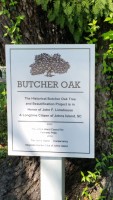Butcher Oak
 The Butcher Oak: A Johns Island Tree with Stories to Tell
The Butcher Oak: A Johns Island Tree with Stories to Tell
The famous Angel Oak is not the only Johns Island tree with historic significance. The Butcher Oak is located on a traffic island at the intersection of Main, River and Chisholm Roads – a major thoroughfare for Johns Island throughout our history. In the Stono Rebellion of 1739 enslaved peoples used this one of their gathering places. During the Revolutionary War the British established supply depots here as they progressed towards Charleston from Savannah and Seabrook Island.
In more recent times the Butcher Oak area became a major transportation hub for Johns Island. Until the 20th century water was the most efficient mode of transportation – particularly on coastal islands. There were several boat landings on the north side of Johns Island. The earliest crossing in the 1700s was Stono Ferry which linked Johns Island to the mainland near Hollywood. In the 1820s Gueran’s Ferry was established crossing the Stono River near the current Limehouse Bridge. By 1863 Gueran’s Ferry was known as the Johns Island Ferry. Townsend’s Landing was another hub further east towards Fenwick Plantation. The public roads on Johns Island until the mid 19th century were along the rivers surrounding the island: River Road, Bohicket Road and Chisholm Road. Other roads including what is now Main Road were plantation roads for the use of plantation owners. Boat landings were located to facilitate the transportation of crops and supplies. Over time the Johns Island Ferry site came to be the central point of transit on the north side of the island.
With boat traffic crossing the Stono, the landing was a key site for people on Johns Island to gather and a natural location for a general store, post office and polling place. The original store near the site was Hutchinson’s Store. After the Civil War as the population expanded, the country stores became even more important. In 1902 John Limehouse established John F. Limehouse General Merchandise. His pork sausage was highly regarded by island residents and businessmen traveled from Charleston to enjoy his sausage. He raised pigs on rented
land at Fenwick Hall. And the large oak tree near the site of the store became known as the Butcher Oak in recognition of John Limehouse’s skills.
In the 1910s the Stono Ferry operator went bankrupt and Limehouse kept the ferry running at a loss until a narrow wooden bridge was built to replace it in 1921. In 1958 a swing bridge was constructed and named in honor of John F. Limehouse. The removal of this bridge was mandated by the Coast Guard in 1994. By this time traffic on the Intercoastal Waterway had increased to the point where the old swing bridge was deemed an obstruction to vessel traffic. The new John F. Limehouse Memorial Bridge was completed in 2003. The debris from the demolished swing bridge was donated to the South Carolina Department of Natural Resources artificial reef program. It was transported to construct the Kiawah Reef site about 23 miles away.
John F. Limehouse II continued to run his father’s store after his retirement. By the mid 20th century the store also sold ice cream which provided many residents with an extra reward when they traveled to the store for their weekly shopping. The store was still in operation in the mid 1960s.
The Butcher Oak was in danger in the 1980s when planned widening of the intersection of Main, River and Chisholm called for its removal. Although Charleston County’s tree ordinance provides protection for such grand trees, public utilities and agencies are exempt. Fortunately clearer heads prevailed and a second lane for right turns from Chisholm onto Main Road was cut through, providing an island for the tree.
As Magnolia Garden Club members who have worked on tidying up this island can attest, this is still a major crossroads for Johns Island. There is considerable traffic moving through this area: large trucks, cars and trailered boats. And the great Butcher Oak still stands in witness to all this change.
Sources: A Place Called St John’s by Laylon Wayne Jordan and Elizabeth H. Stringfellow, 1998. Images of America: John’s Island by Connie Walpole Haynie, 2007. James Island and Johns Island Historical Survey . Preservation Consultants for SC Dept of Archives and History, Charleston County and the City of Charleston, 1989.
Compiled by Magnolia Garden Club of Johns Island Arbor Day (December 5) 2014.